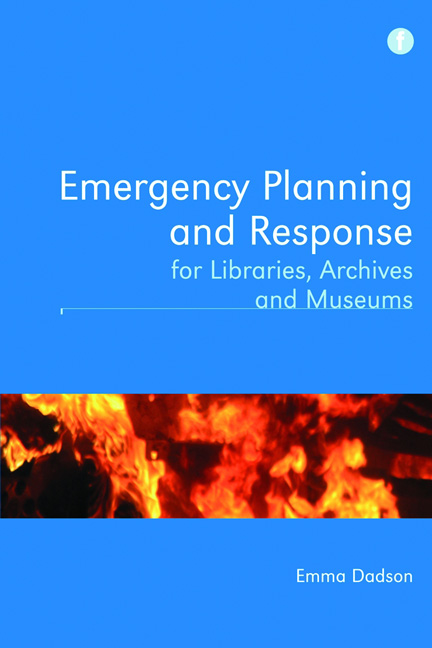Book contents
- Frontmatter
- Contents
- Foreword
- Preface
- Acknowledgements
- 1 Introduction
- 2 Case studies
- 3 Roles and responsibilities
- 4 Incident control
- 5 Planning the recovery operation
- 6 Collections salvage
- 7 Supplementary content
- 8 Dealing with the building
- 9 Business continuity
- 10 Ensuring the plan's efficacy
- 11 Conclusion
- Bibliography and references
- Index
- Frontmatter
- Contents
- Foreword
- Preface
- Acknowledgements
- 1 Introduction
- 2 Case studies
- 3 Roles and responsibilities
- 4 Incident control
- 5 Planning the recovery operation
- 6 Collections salvage
- 7 Supplementary content
- 8 Dealing with the building
- 9 Business continuity
- 10 Ensuring the plan's efficacy
- 11 Conclusion
- Bibliography and references
- Index
Summary
The bizarre feature of emergency planning and its surrounding training is that an organization hopes never to have to implement its content in a real situation that threatens people, collections, the building or the business, despite all the hard work invested in the creation of the document. As threats to collections can never be minimized absolutely, a residual risk will always remain and so emergency planning is required. Effective emergency planning should ensure that the response to any such incident operates as efficiently as possible.
The book has demonstrated information that institutions globally have found useful when responding to heritage and information services collections under threat of damage, or wished that they had had in hindsight. If this emergency plan information is presented well, and colleagues are familiar with how to use and navigate the document, it should be extremely useful in a real incident. Having suggested formats for forms, content for salvage guidance notes and suggestions on how roles and responsibilities may be allocated, this should provide a useful point of comparison to any institution reviewing its existing plan or an institution starting from scratch. The most important aspects from practical disaster recovery experience are to ensure that staff are clear on their role and clear on what they are authorized to do if incident control is to operate smoothly.
Every library, archive and museum is different. A bespoke plan must be crafted for each institution, working on the basis of formats suggested within this book and templates from other comparable institutions, but developed into something fully reflecting the dynamics of the individual institution. It may be tempting to copy another institution's document but such plans rarely work effectively.
Training is key. A plan may have very good content, but if those implementing it lack familiarity or confidence in its content, the plan will not deliver operational effectiveness. Regular training will deliver real results if your plan has to be implemented in real situations.
- Type
- Chapter
- Information
- Publisher: FacetPrint publication year: 2012



